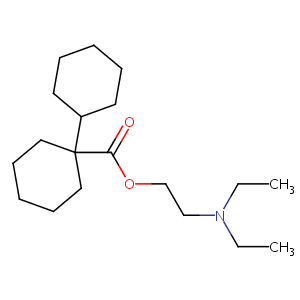Drug Information
| Drug General Information | Top | |||
|---|---|---|---|---|
| Drug ID |
D07XJM
|
|||
| Former ID |
DAP001118
|
|||
| Drug Name |
Dicyclomine
|
|||
| Synonyms |
Atumin; Bentomine; Bentylol; Dicicloverina; Dicycloverin; Dicycloverine; Dicycloverinum; Dicymine; Diocyl; Dyspas; Formulex; Mamiesan; Merbentyl; Procyclomin; Sawamin; Spasmoban; Wyovin; Bentyl hydrochloride; Bentylol hydrochloride; Dicyclomine Hcl; Dicycloverin hydrochloride; Diethylaminocarbethoxybicyclohexyl hydrochloride; Diocyl hydrochloride; Kolantyl hydrochloride; Wyovin hydrochloride; GU8471000; Bentyl (TN); Bentylol (TN); Byclomine (TN); Di-syntramine; Dibent (TN); Dicicloverina [INN-Spanish]; Dicycloverine (INN); Dicycloverine [INN:BAN]; Dicycloverinum [INN-Latin]; Dicymine (TN); Dilomine (TN); Formulex (TN); Lomine (TN); Merbentyl (TN); Oxityl-P; Beta-Diethylaminoethyl 1-cyclohexylcyclohexanecarboxylate hydrochloride; Di-Spaz (TN); J.L. 998; Beta-Diethylaminoethyl-1-cyclohexylhexahydrobenzoate hydrochloride; Bicyclohexyl-1-carbonsaeure-2'diethylaminoethylester; [Bicyclohexyl]-1-carboxylic acid, 2-(diethylamino)ethyl ester hydrochloride; Cyclohexanecarboxylic acid, 1-cyclohexyl-, 2-(diethylamino)ethyl ester; [1,1'-Bicyclohexyl]-1-carboxylic acid, 2-(diethylamino)ethyl ester; (1,1'-Bicyclohexyl)-1-carboxylic acid, 2-(diethylamino)ethyl ester; (BICYCLOHEXYL)-1-CARBOXYLIC ACID, 2-(DIETHYLAMINO)ETHYL ESTER, HYDROCHLORIDE; (Bicyclohexyl)-1-carboxylic acid, 2-(diethylamino)ethyl ester; 1-Cyclohexylcyclohexanecarboxylic acid 2-(diethylamino)ethyl ester; 2-(diethylamino)ethyl 1,1'-bi(cyclohexyl)-1-carboxylate; 2-(diethylamino)ethyl 1-cyclohexylcyclohexane-1-carboxylate; 2-diethylaminoethyl 1-cyclohexylcyclohexane-1-carboxylate; 2-diethylaminoethyl 1-cyclohexylcyclohexane-1-carboxylate hydrochloride
Click to Show/Hide
|
|||
| Drug Type |
Small molecular drug
|
|||
| Indication | Functional bowel syndrome [ICD-11: DD91.0; ICD-10: K58] | Approved | [1] | |
| Therapeutic Class |
Anticholinergic Agents
|
|||
| Company |
Peckforton Pharmaceuticals
|
|||
| Structure |
 |
Download2D MOL |
||
| Formula |
C19H35NO2
|
|||
| Canonical SMILES |
CCN(CC)CCOC(=O)C1(CCCCC1)C2CCCCC2
|
|||
| InChI |
1S/C19H35NO2/c1-3-20(4-2)15-16-22-18(21)19(13-9-6-10-14-19)17-11-7-5-8-12-17/h17H,3-16H2,1-2H3
|
|||
| InChIKey |
CURUTKGFNZGFSE-UHFFFAOYSA-N
|
|||
| CAS Number |
CAS 77-19-0
|
|||
| PubChem Compound ID | ||||
| PubChem Substance ID |
9166, 579063, 5394320, 7979069, 8151936, 10535471, 11111098, 11112188, 11335337, 11360576, 11363828, 11366390, 11368952, 11371495, 11374196, 11377114, 11461548, 11466076, 11467196, 11484176, 11485832, 11488406, 11490204, 11492324, 11494748, 15048766, 29222188, 46505371, 47440119, 47662128, 47662129, 48034974, 48110323, 48184864, 48259084, 48334352, 48415886, 49698855, 49957700, 50065186, 50100226, 50104289, 57321573, 80483160, 85209403, 85789477, 90341021, 96024517, 99313632, 103318016
|
|||
| ChEBI ID |
CHEBI:4514
|
|||
| ADReCS Drug ID | BADD_D00659 ; BADD_D00660 | |||
| SuperDrug ATC ID |
A03AA07
|
|||
| SuperDrug CAS ID |
cas=000077190
|
|||
| Interaction between the Drug and Microbe | Top | |||
|---|---|---|---|---|
| The Metabolism of Drug Affected by Studied Microbe(s) | ||||
| The Order in the Taxonomic Hierarchy of the following Microbe(s): Bacteroidales | ||||
|
Studied Microbe: Bacteroides dorei DSM 17855
Show/Hide Hierarchy
|
[2] | |||
| Hierarchy | ||||
| Experimental Method | High-throughput screening | |||
| Description | Dicyclomine can be metabolized by Bacteroides dorei DSM 17855 (log2FC = -0.817; p = 0.001). | |||
|
Studied Microbe: Bacteroides vulgatus ATCC 8482
Show/Hide Hierarchy
|
[2] | |||
| Hierarchy | ||||
| Experimental Method | High-throughput screening | |||
| Description | Dicyclomine can be metabolized by Bacteroides vulgatus ATCC 8482 (log2FC = -0.585; p = 0.033). | |||
|
Studied Microbe: Bacteroides xylanisolvens DSM18836
Show/Hide Hierarchy
|
[2] | |||
| Hierarchy | ||||
| Experimental Method | High-throughput screening | |||
| Description | Dicyclomine can be metabolized by Bacteroides xylanisolvens DSM18836 (log2FC = -0.461; p = 0.007). | |||
|
Studied Microbe: Parabacteroides distasonis ATCC 8503
Show/Hide Hierarchy
|
[2] | |||
| Hierarchy | ||||
| Experimental Method | High-throughput screening | |||
| Description | Dicyclomine can be metabolized by Parabacteroides distasonis ATCC 8503 (log2FC = -0.394; p = 0.012). | |||
|
Studied Microbe: Pretovella copri DSM 18205
Show/Hide Hierarchy
|
[2] | |||
| Hierarchy | ||||
| Experimental Method | High-throughput screening | |||
| Description | Dicyclomine can be metabolized by Pretovella copri DSM 18205 (log2FC = -0.373; p = 0.013). | |||
| The Order in the Taxonomic Hierarchy of the following Microbe(s): Eggerthellales | ||||
|
Studied Microbe: Eggerthella lenta ATCC 25559
Show/Hide Hierarchy
|
[2] | |||
| Hierarchy | ||||
| Experimental Method | High-throughput screening | |||
| Description | Dicyclomine can be metabolized by Eggerthella lenta ATCC 25559 (log2FC = -0.546; p = 0.007). | |||
| The Order in the Taxonomic Hierarchy of the following Microbe(s): Eubacteriales | ||||
|
Studied Microbe: Ruminococcus torques ATCC 27756
Show/Hide Hierarchy
|
[2] | |||
| Hierarchy | ||||
| Experimental Method | High-throughput screening | |||
| Description | Dicyclomine can be metabolized by Ruminococcus torques ATCC 27756 (log2FC = -0.695; p = 0.016). | |||
| The Abundace of Studied Microbe(s) Regulated by Drug | ||||
| The Order in the Taxonomic Hierarchy of the following Microbe(s): Eubacteriales | ||||
|
Studied Microbe: Eubacterium eligens
Show/Hide Hierarchy
|
[3] | |||
| Hierarchy | ||||
| Abundance Change | Decrease | |||
| Experiment Method | High-throughput screening | |||
| Description | The abundance of Eubacterium eligens was decreased by Dicyclomine hydrochloride (adjusted p-values: 2.81E-03). | |||
| References | Top | |||
|---|---|---|---|---|
| REF 1 | Drugs@FDA. U.S. Food and Drug Administration. U.S. Department of Health & Human Services. 2015 | |||
| REF 2 | Mapping human microbiome drug metabolism by gut bacteria and their genes. Nature. 2019 Jun;570(7762):462-467. | |||
| REF 3 | Extensive impact of non-antibiotic drugs on human gut bacteria. Nature. 2018 Mar 29;555(7698):623-628. | |||
| REF 4 | [Characterization of muscarinic receptors in undifferentiated thyroid cells in Fisher rats]. Endocrinol Nutr. 2009 Mar;56(3):106-11. | |||
| REF 5 | Fustin flavonoid attenuates beta-amyloid (1-42)-induced learning impairment. J Neurosci Res. 2009 Dec;87(16):3658-70. | |||
If You Find Any Error in Data or Bug in Web Service, Please Kindly Report It to Dr. Zhou and Dr. Zhang.

